#pulsar synthesis
Explore tagged Tumblr posts
Text
youtube
#lauren sarah hayes#wavetable#edinburgh#modular synth#pulsar synthesis#live electronics#improvisation#electronic music#experimental music#noise#noise music#Youtube
0 notes
Text
End of semester post-crab nebula
The Crab Nebula is a celestial wonder that never fails to capture the imagination. This nebula is the remnants of a supernova explosion that was observed by humans way back in the year 1054 (Rodriguez). Can you believe it? It's been captivating stargazers for centuries!
The Crab Nebula is located in the constellation Taurus, about 6,500 light-years away from us (Rodriguez). It's one of the most studied objects in the night sky because it offers a unique opportunity to study the aftermath of a supernova explosion up close. The explosion itself was incredibly powerful, releasing an enormous amount of energy and creating a shockwave that propelled material into space at incredible speeds.
Now, what makes the Crab Nebula even more fascinating is its pulsar, which is a rapidly spinning neutron star at its center. This pulsar emits beams of radiation that sweep across our line of sight, much like a cosmic lighthouse. These beams of radiation are so precise that they're like a ticking clock in space, pulsing with incredible regularity.
The Crab Nebula is a testament to the power and beauty of the universe. It reminds us of the dynamic and ever-changing nature of the cosmos.
The Crab Nebula, also known as M1, is a supernova remnant and a pulsar wind nebula that resides in the constellation Taurus. It's the result of a supernova explosion, which was recorded by Chinese astronomers in 1054 (Rodriguez). The core of the exploded star formed a neutron star, which is incredibly dense – so dense that a teaspoon of its material would weigh about a billion tons!
This neutron star, also known as the Crab Pulsar, spins approximately 30 times per second. As it spins, it emits a beam of electromagnetic radiation that can be detected as pulses of radio waves, visible light, X-rays, and gamma rays. The pulsar is about 20 to 30 kilometers in diameter, and it's the powerhouse that energizes the entire nebula.
The Crab Nebula itself is expanding at a rate of about 1,500 kilometers per second (Rodriguez). As the ejected material from the supernova moves outward, it interacts with the interstellar medium, creating the intricate filaments and complex structures we see. These filaments contain a mix of gases, primarily hydrogen and helium, along with other elements synthesized in the progenitor star.
What's particularly interesting about the Crab Nebula is that it's one of the few astronomical objects where we can actually see the dynamics of the nebula changing over human timescales. Observations over several years show noticeable changes in the nebula's structure.
In terms of its significance, the Crab Nebula is a key source for studying the extreme physical processes involved in pulsars and supernova remnants. It's also important for understanding the synthesis of heavy elements and the role of supernovae in seeding the universe with these elements, which are crucial for the development of planets and life as we know it.
The Crab Nebula's brightness across the electromagnetic spectrum makes it a natural laboratory for astrophysics. It's one of the most intense gamma-ray sources in the sky, and this high-energy radiation provides insights into the most energetic particles and forces in our universe.
The Crab Nebula is not just a pretty sight; it's a treasure trove of information for scientists. Here are some more intriguing facts:
Cosmic Generator: The Crab Nebula's pulsar is so energetic that it's essentially powering the nebula. The fast-spinning neutron star is shooting out a wind of charged particles, which lights up the nebula and creates the glow that we can observe across various wavelengths.
Historical Record: The event that created the Crab Nebula was one of the few historical supernovae visible to the naked eye. Its appearance in 1054 was documented by astronomers in various cultures, including Chinese and Native American (Rodriguez).
Size and Distance: The nebula is about 10 light-years across, and as mentioned, it's around 6,500 light-years away from Earth. Despite this vast distance, it's one of the most studied objects in the night sky.
A Window to the Past: Since the light from the Crab Nebula takes 6,500 years to reach us, we're actually looking at an image of the nebula as it was 6,500 years ago 9Rodriguez). This provides an incredible opportunity for astronomers to study the historical evolution of supernova remnants.
A Source of Insight: The Crab Nebula is also a source of cosmic rays, which are high-energy particles that bombard Earth. Studying these particles helps scientists understand more about the origins and acceleration mechanisms of cosmic rays.
X-ray Vision: In the 1960s, the Crab Nebula was one of the first sources of X-rays discovered outside our solar system 9rodriguez). This discovery helped to establish the field of X-ray astronomy.
Cultural Impact: The Crab Nebula has made its way into various aspects of pop culture, including literature and television. It's often used as a symbol for cosmic phenomena and has been featured in science fiction stories.
Let's dive into the world of quantum mechanics for a bit:
Spooky Action at a Distance: Quantum entanglement is a phenomenon where particles become interconnected and the state of one instantly influences the state of another, regardless of the distance separating them.
Uncertainty Principle: Werner Heisenberg's Uncertainty Principle states that you cannot simultaneously know the exact position and momentum of a particle. The more precisely one is known, the less precise the measurement of the other is.
Wave-Particle Duality: Quantum objects exhibit both wave-like and particle-like properties (Rodriguez). Depending on how you measure them, they can appear as particles or as waves. This duality is central to quantum mechanics.
Quantum Tunneling: Particles can pass through barriers that, according to classical physics, should be impenetrable. This tunneling is what allows the sun to shine, as it powers nuclear fusion.
Quantum Superposition: This principle allows a particle to be in multiple states at the same time. It's famously illustrated by Schrödinger's cat thought experiment, where a cat in a box can be both alive and dead until it's observed (Rodriguez).
Quantum Computing: Utilizing quantum bits or qubits, which can be in superpositions of states, quantum computers have the potential to process exponentially more data compared to classical computers.
Quantum Decoherence: This is the loss of quantum behavior as a quantum system interacts with its environment, causing it to transition into classical states.
These concepts are just the tip of the iceberg, but they offer a glimpse into the strange and fascinating world of quantum mechanics, where the usual rules of physics as we know them are turned upside down.
The Crab Nebula continues to be an object of fascination, not just for its historical significance, but also for the role it plays in helping us understand the universe. It's a cosmic beacon that reminds us of the incredible events that can occur in space.
0 notes
Text
youtube
TourdeForce - Compendium, vol.1 (trailer) Out June 17, 2022 via Space Race Records (CD digipak + booklet) The tracklist of this compilation titled "Compendium, Vol. 1" includes an amazing selection of fourteen songs made between 2009 and 2013 during the "Colours in Life" era, some of them masterfully remixed for this special occasion by prestigious names from the electronic scene such as Syrian, Foretaste, Luca Urbani (Soerba) and Dekad. Those artists are also to be considered as special guests by adding extra vocals to their reworks, providing a unique listening experience. This publication also features brand-new mixes, rare and unreleased tracks such as "Falling in The Dark" (thought to be lost for years, produced in 2012 for the Japanese Eurobeat market), an episode featuring Nova Pulsar (Ecuador) and two delightful demo versions. "Compendium, Vol. 1" proudly celebrates the virtues of TourdeForce, providing a first, thoughtful synthesis of the project distinctive music.

0 notes
Text

Prepare to be captivated by the enigmatic and ethereal soundscape of "Dark Energy Synthesis," an album that pushes the boundaries of acousmatic music, experimental compositions, and the realms of dub, drone, power noise and electronics. In this album, we delve into the mesmerizing sonic realm of "Dark Energy Synthesis," where the cosmic meets the earthly, and the abstract intertwines with the familiar. Embark on a transcendental voyage as the album unfolds, enveloping your senses in a tapestry of otherworldly tones, pulsating noise rhythms, and intricate layers of sound in a post-minimal, post-techno, and post-digital aesthetic.
Uncharted Sonic Territories An Immersive Sonic Experience "Dark Energy Synthesis" harnesses the power of sonic alchemy, fusing elements of dub, power noise, techno and electronica to create an immersive experience like no other. The album takes listeners on a sonic acousmatic rollercoaster ride, where dub-infused basslines meld with intricate glitch beats and atmospheric micro and macro noise soundscapes. The result is an intoxicating blend of head-nodding rhythms and mind-expanding textures that will leave you craving more.
Challenging Conventions This audacious album is not for the faint of heart. It challenges conventions and dares to explore uncharted sonic territories in acousmatic tape music, inviting listeners to embark on a journey of self-discovery and introspection. "Dark Energy Synthesis" opens up new directions for acousmatic music, pushing the boundaries of what is possible in the realm of experimental compositions and electronica. A Musical Odyssey This album defies categorization, taking listeners on a musical odyssey through evocative compositions that challenge traditional norms. It is an essential addition to any music lover's collection, a sonic masterpiece that immerses listeners in an intricate web of sounds and textures. Embrace the Enigmatic Allure Unleash the Power of Sonic Exploration "Dark Energy Synthesis" invites listeners to embrace the unknown and unlock the mysteries of sound. Surrender to the enigmatic world that awaits, as pulsating rhythms, haunting melodies, and mesmerizing soundscapes transport you to new dimensions of musical ecstasy. A Journey of Self-Discovery The album's immersive compositions wash over you, offering a universe where dark energy and light synthesis intertwine. "Dark Energy Synthesis" becomes a gateway to introspection and self-discovery, offering a transformative experience through its captivating sounds. Conclusion "Dark Energy Synthesis" is an album that challenges, captivates, and awakens the senses. It transcends conventional musical boundaries, offering a unique blend of dub, noise, post-techno and electronica within the realm of acousmatic music. Embark on this auditory journey, embrace the enigmatic allure, and immerse yourself in a sonic universe where creativity knows no bounds. Surrender to the power of "Dark Energy Synthesis" and experience a transformative musical exploration.
credits
released July 24, 2023
Composer by Da Mata Paquete aka Hugo Paquete in the Absonus Lab a space for sonic experimentation that provides the conditions to foster music creativity and further development in multidisciplinary advances in art, science and technology. Year: 2023
www.absonuslab.org
license
all rights reserved
#music#art#da mata paquete#sound#composition#sound art#noise#hugo paquete#new media#performance#acousmatic#acousmatic music#nosie music#power eletronics#eletronic music#post-digital#new media art#Bandcamp
1 note
·
View note
Text
Rivelate le onde gravitazionali di fondo dell'Universo

Onde gravitazionali: la scoperta che rivela il respiro dell’universo. Alla ricerca pubblicata sulla rivista Astronomy and Astrophysics, hanno contribuito la collaborazione europea Epta, della quale l’Italia fa parte con l’Istituto Nazionale di Astrofisica (sede di Cagliari) e l’Università di Milano Bicocca Lo definiscono “il respiro dell'universo”, si tratta del rumore di fondo che gli astronomi sono riusciti ad ascoltare grazie a una tecnica per la rilevazione delle onde gravitazionali. Una novità che, come sottolineano, apre una “nuova finestra sull'universo”. Un risultato importante, pubblicato su The Astrophysical Journal Letter frutto di uno studio e progetto di ricerca che ha visto la collaborazione di più scienziati. Gli studiosi hanno osservato per la prima volta le deboli increspature causate dal movimento dei buchi neri che stanno dolcemente allungando e comprimendo ogni cosa nell’universo. Mercoledì, hanno riferito di essere stati in grado di “sentire” quelle che vengono chiamate onde gravitazionali a bassa frequenza, “cambiamenti nel tessuto dell’universo creati da enormi oggetti che si muovono e si scontrano nello spazio”. La prima volta, come sottolineato da Maura McLaughlin, co-direttrice di NANOGrav, North American Nanohertz Observatory for Gravitational Waves che «abbiamo prove di questo movimento su larga scala di tutto nell’universo». A spiegare quanto sia importante questa scoperta è Michele Vallisneri, senior research scientist al Jet Propulsion Laboratory della NASA nella California del sud. Questa scoperta rivela che l’intero universo è immerso in un rumore di fondo di onde gravitazionali, provenienti dalle binarie di buchi neri al centro delle galassie, e suggerisce che queste binarie esistono in gran numero - dice -. La tecnica di rivelazione è quasi incredibile: abbiamo monitorato per 15 anni la pulsazione regolare proveniente da 67 stelle di neutroni nella galassia, per misurare lo stiramento e compressione dello spaziotempo». Alla scoperta delle onde gravitazionali a bassissima frequenza e ultra-lunghe hanno contribuito in modo importante l’Europa, con la collaborazione European Pulsar Timing Array (Epta), e l’Italia grazieall’Istituto Nazionale di Astrofisica, con la sua sede di Cagliari, e l’Università di Milano Bicocca. Il risultato si deve a 13 telescopi di tutto il mondo. Di questi, 5 sono europei, fra cui il Sardinia Radio Telescope. All’interno delle 11 istituzioni europee che fanno parte dell’Epta, astronomi e fisici teorici hanno collaborato per utilizzare i dati relativi a 15 pulsar, stelle molto dense che ruotano su sé stesse, il cui ritmo è alterato dal passaggio delle nuove onde gravitazionali. Distanti dalla Terra e disseminate nella Via Lattea, le pulsar sono diventate un unico rivelatore cosmico ai limiti della fantascienza. Le variazioni nella loro rotazione misurate dai 13 radiotelescopi riflettono infatti le dilatazioni e le compressioni dello spazio-tempo, la cui regolarità ricorda quella del respiro. L’organizzazione europea ha partecipato a un grande lavoro disquadra con i ricercatori indiani e giapponesi dell’Indian Pulsar Timing Array (InPta) e gli altri cacciatori di pulsar attivi nel mondo, come la collaborazione nordamericana NanoGrav,l’australiana Ppta e la cinese Cpta. Con il Sardinia RadioTelescope, i radiotelescopi che hanno permesso la scoperta sono l’Effelsberg Radio Telescope in Germania, il Lovell Telescope dell’Osservatorio Jodrell Bank nel Regno Unito, il Nancay Radio Telescope in Francia e il Westerbork Radio Synthesis Telescope nei Paesi Bassi. Per il presidente dell’Istituto Nazionale di Astrofisica, Marco Tavani si tratta di “risultati straordinari per la loro importanza scientifica e per le prospettive future di ulteriore consolidamento dei risultati». I risultati appena pubblicati, rileva, sono «una pietramiliare per l’astrofisica contemporanea: da un lato aprono una nuova finestra osservativa nella scienza delle onde gravitazionali e dall’altro confermano l’esistenza di onde gravitazionali ultra lunghe che, secondo le teorie correnti, dovrebbero essere generate da coppie di buchi neri super-massicci formatisi nel corso del processo di fusione frale galassie». I risultati dell’EPTA si confrontano con una serie di pubblicazioni oggi annunciate in parallelo da altre collaborazioni in tutto il mondo. L'insieme di dati dell'EPTA è straordinariamente lungo e denso ed ha permesso di ampliare la finestra di frequenza in cui possiamo osservare queste onde - fa sapere Alberto Sesana professore all’università Milano Bicocca - permettendo una migliore comprensione della fisica delle galassie che si fondono e dei buchi neri super massicci che esse ospitano». Nataliya Porayko, ‘visiting researcher' all'Università di Milano-Bicocca tuttavia sottolinea che «una regola d'oro in fisica per conclamare la scoperta di un nuovo fenomeno è che il risultato dell’esperimento abbia una probabilità di verificarsi casualmente meno di una volta su un milione». Il risultato riportato da EPTA - così come dalle altre collaborazioni internazionali - non soddisfa ancora questo criterio, infatti c'è ancora circa una probabilità su mille che fonti di rumore casuali cospirino per generare il segnale. C’è poi l’altra faccia della ricerca e riguarda il progetto dell’Einstein Telescope. «L’astronomia gravitazionale alle frequenze più basse (nanohertz) con le pulsar è complementare al programma degli interferometri terrestri come LIGO, Virgo, e in futuro ET che puntano a frequenze più alte (decahertz) - conclude Michele Vallisneri -. Mentre la prima rivela i buchi neri supermassivi ed effetti cosmologici esotici, i secondi studiano la ricchissima fenomenologia dei buchi neri stellari e delle stelle di neutroni. Così come sondiamo l’universo utilizzando parti diverse dello spettro elettromagnetico (da onde radio al visibile ai raggi gamma), così vogliamo estendere la “finestra” gravitazionale a tutte le frequenze, per esplorare tutti gli aspetti dell’universo oscuro». Meloni: con Einstein Telescope Italia e Ue al passo con attori globali Read the full article
0 notes
Video
youtube
Expert Sleepers has yet another Disting update ready to install. They never stop! The best thing about this version is the addition of the Pulsar VCO.
0 notes
Text
This fast radio burst repeats in a strict pattern, and we still can't figure out why
https://sciencespies.com/space/this-fast-radio-burst-repeats-in-a-strict-pattern-and-we-still-cant-figure-out-why/
This fast radio burst repeats in a strict pattern, and we still can't figure out why
After taking new radio observations, astronomers have ruled out a leading explanation for the cyclic nature of a particularly curious repeating space signal.
The signal in question is FRB 20180916B, which repeats with a 16.35-day periodicity. According to existing models, this could result from interactions between closely orbiting stars; however, the new detections – which include fast radio burst (FRB) observations at the lowest frequencies yet – do not make sense for such a binary system.
“Strong stellar winds from the companion of the fast radio burst source were expected to let most blue, short-wavelength radio light escape the system. But the redder long-wavelength radio should be blocked more, or even completely,” said astrophysicist Inés Pastor-Marazuela of the University of Amsterdam and ASTRON in the Netherlands.
“Existing binary-wind models predicted the bursts should shine only in blue, or at least last much longer there. But we saw two days of bluer radio bursts, followed by three days of redder radio bursts. We rule out the original models now – something else must be going on.”
Fast radio bursts are one of the most fascinating mysteries in the cosmos. They’re extremely short bursts of very powerful short-wavelength radio waves – as in, just milliseconds in duration, and discharging as much energy as 500 million Suns in that time. Most of the FRB sources we’ve detected have only been seen once; this makes them unpredictable and hard to study.
A few FRB sources have been detected repeating, although most have done so erratically. FRB 20180916B is one of the two exceptions found repeating on a cycle, which makes it an excellent case for learning more about these mysterious events.
Last year, we also got a major lead on what could be causing FRBs – the first such signal detected coming from within the Milky Way. It was spat out by a magnetar, a type of neutron star with an insanely powerful magnetic field.
But that doesn’t mean the case is entirely solved. We don’t know why some FRBs repeat, and others don’t, for instance – and why, for the repeating FRBs, periodicity has only been detected rarely.
When FRB 20180916B was found to repeat on a cycle, one of the leading explanations was that the neutron star emitting the burst was in a binary system with a 16.35-day orbit. If this were the case, then lower-frequency, longer radio wavelengths should be altered by the charged wind of particles surrounding the binary.
Pastor-Marazuela and her colleagues used two telescopes to make simultaneous observations of the FRB – the Low Frequency Array (LOFAR) radio telescope, and the Westerbork Synthesis Radio Telescope, both headquartered in the Netherlands. When they analyzed the data, they found redder wavelengths in the LOFAR data – meaning that binary winds could not be present to block them.
Nor, for that matter, could other low-frequency absorbing or scattering mechanisms, such as dense electron clouds.
“The fact that some fast radio bursts live in clean environments, relatively unobscured by any dense electron mist in the host galaxy, is very exciting,” said astronomer Liam Connor of the University of Amsterdam and ASTRON.
“Such bare fast radio bursts will allow us to hunt down the elusive baryonic matter that remains unaccounted for in the Universe.”
So if the binary explanation is ruled out, what could be causing the periodicity? Well, it’s still not aliens, sorry.
One explanation suggested last year involves a single object, such as a rotating magnetar or pulsar. This was thought to be a poorer fit for the data than binary wind of charged particles, since those objects have a wobbling rotation that produces periodicity, and none are known to wobble that slowly.
But with the binary wind off the table, thanks to the LOFAR and Westerbork observations, a slowly wobbling magnetar is back on it. And this suggests we still have quite a bit to learn about both magnetars and FRBs.
“An isolated, slowly rotating magnetar best explains the behavior we discovered,” Pastor-Marazuela said.
“It feels a lot like being a detective – our observations have considerably narrowed down which fast radio burst models can work.”
The research has been published in Nature.
#Space
#08-2021 Science News#2021 Science News#acts of science#Earth Environment#earth science#Environment and Nature#Nature Science#News Science Spies#Our Nature#planetary science#Science#Science Channel#science documentary#Science News#Science Spies#Science Spies News#Space Physics & Nature#Space Science#Space
1 note
·
View note
Text
TAFAKKUR: Part 404
SCIENTIFIC DISCOVERIES: A NOVEL PERSPECTIVE: Part 2
TEFLON
From non-stick frying pans to space suits to artificial heart valves, Teflon has found several areas of application. Its discovery resulted from an apparently ‘accidental’ observation by a young chemist, R. Plunket, working in Du Pont laboratories. On April 6, 1938, Plunket opened a tank of gaseous tetrafluoerothylene in the hope of preparing a non-toxic refrigerant from it, but no gas came out, to the surprise of Plunkett and his assistant. Plunkett could not understand this because the weight of the tank indicated that it should be full of the gaseous fluorocarbon.
Instead of discarding the tank and getting another in order to get on with his refrigerant research, Plunkett decided to satisfy his curiosity about the ‘empty tank’. Having determined that the valve was not faulty by running a wire through its opening, he sawed the tank open and looked inside. There he found a waxy white powder and, being a chemist, he realized what it must mean.
The molecules of the gaseous tetrafluoroethylene had combined with one another ‘polymerized’ to such an extent that they now formed a solid material. The waxy white powder did indeed have remarkable properties: it was more inert than sand - not affected by strong acids, bases or heat and no solvent could dissolve it - but, in contrast to sand, it was extremely slippery.
X (ROENTGEN) RAYS
Physicist W. Roentgen discovered the rays which were later to be named after him, in an unexpected and unplanned manner. Roentgen was repeating experiments by other physicists in which electricity at high voltage was discharged through air or other gases in a partially evacuated glass tube. We now know that cathode rays are actually streams of electrons being emitted from the cathode, and the impact of these electrons on the walls of the glass tubes produces the phosphorescence.
In 1892, it was demonstrated that cathode rays could penetrate thin metallic foils. Discharge tubes having thin aluminium windows allowed the cathode rays to pass out of the tube where they could be detected by the light they produced on a screen of phosphorescent material (such screens were also used to detect ultraviolet light), but they were found to travel only two or three centimetres in the air at ordinary pressure outside the evacuated tube.
Roentgen repeated some of these experiments to familiarize himself with the techniques. He then decided to see whether he could detect cathode rays issuing from an evacuated all-glass tube, that is, one with no thin aliminium window. Na one had observed cathode rays under these conditions. Roentgen thought the reason for the failure might be that strong phosphorescence of the cathode tube obscured the weak fluorescence of the detecting screen. To test this theory, he devised a black cardboard cover for the cathode tube. To determine the effectiveness of the shield, he then darkened the room and turned on the high voltage coil to energize the tube. Satisfied that his black shield did indeed cover the tube and allowed no phosphorescent light to escape, he was about to shut off the coil and turn on the room lights so that he could position the phosphorescent screen at varying short distances from the vacuum tube:
Just at that moment, he noticed a weak light shimmering from a point in the dark room more than a yard from the vacuum tube. At first, he thought there must be, after all, a light leak from the black mask around the tube, which was being reflected from a mirror in the room. However, there was no mirror. When he passed another series of charges through the cathode tube, he saw the light appear in the same location again, looking like faint green clouds moving in synchronism with the fluctuating discharges of the cathode tube. Hurriedly lighting a match, Roentgen found to his amazement that the source of the mysterious light was the little fluorescent screen that he had planned to use as a detector near the blinded cathode tube, but it was lying on the bench more than a yard from the tube.
Roentgen realized immediately that he had encountered an entirely new phenomenon. These were not cathode rays that lit up the fluorescent screen more than a yard from the tube! With feverish activity, he devoted himself single-mindedly in the next several weeks to exploring this new form of radiation. He reported his findings in a paper published in Wunburg, dated December 28, 1895, and entitled ‘A New Kind of Ray, a Preliminary Communication’. Although he described accurately most of the basic qualitative properties of the new rays in this paper, his acknowledgement that he did not yet fully understand them was indicated by the name he chose for them, X-rays. (They have also often been called Roentgen rays.)
He reported that the new rays were not affected by a magnet, as cathode rays were known to be. Not only would they penetrate more than a yard of air, in contrast to the two or three inch limit of cathode rays, but also (to quote his paper):
‘All bodies are transparent to this agent, though in very different degrees. Paper is very transparent; behind a bound book of about one thousand pages I saw the fluorescent screen light up brightly. In the same way the fluorescence appeared behind a double pack of cards. Thick blocks of wood are also transparent, pine boards two or three centimetres thick absorbing only slightly. A plate of aluminium about fifteen millimetres thick, though it enfeebled the action seriously, did not cause the fluorescence to disappear entirely. If the hand be held between the discharge tube and the screen, the darker shadow of the bones is seen within the slightly dark shadow image of the hand itself.’
He found that he could even record such skeletal images on photographic film. This property of X-rays captured the attention of the medical world immediately. In an incredibly short time X-rays were used routinely for diagnosis in hospitals throughout the world.
INSULIN
If a relative or a friend of yours has diabetes, you will probably know how important insulin is for them. As a partial remedy for most diabetics today, insulin was discovered as an answer to the prayers of hundreds of thousands of diabetics by the Most Merciful One. Perhaps, even better relief and remedy are awaiting discovery in some unexpected time or place.
In 1889, while studying the function of the pancreas in digestion, two researchers removed the pancreas from a dog. The very next day a laboratory assistant called their attention to a swarm of flies around the urine from this dog. Curious about why the flies were attracted to the urine, they analysed it and found it was loaded with sugar. Sugar in urine is a common sign of diabetes.
The researchers realized that they were seeing for the first time evidence of the experimental production of diabetes in an animal. The fact that this animal had no pancreas suggested a relationship between that organ and diabetes. The researchers subsequently proved that the pancreas produces a secretion that controls the use of sugar, and that lack of this secretion causes defects in sugar metabolism then exhibited as symptoms of diabetes.
Many attempts were made to isolate the secretion, with little success until 1921. A young Canadian medical student extracted the secretion from the pancreas of dogs. When they injected the extracts into dogs rendered diabetic by removal of their pancreases, the blood sugar levels of these dogs returned to normal or below, and the urine became sugar-free. The general condition of the dogs also improved.
Until recently, all insulin used for the treatment of human diabetes came from the pancreases of some animals. As a result of genetic engineering, based on knowing how DNA controls protein synthesis, a major pharmaceutical firm has begun to produce human insulin by using bacteria. The fact that a microscopic creature, like the bacterium can be made to work for the wellbeing of human beings is a subject worthy of study on its own.
Of course, these are by no means the only examples worth mentioning of ‘happy, chance discoveries’. Here are some more to add to the list: the discovery of molecular structure of organic compounds, saccharin and nutra-sweet (sugar substitutes, again for diabetics), ‘safety glass used in automobiles and planes, oxygen and several other chemical elements, radioactivity, astronomical discoveries like pulsars and background Big Bang radiation, many mathematical theorems, high temperature superconductors, synthetic dyes, etc., etc.
Can one really call all of these marvellous discoveries simply ‘happy, chance accidents’? I believe human conscience and reason must resist such a misconception. Surely, any person of common sense would say: ‘I am thankful to the Merciful One, who has bestowed upon us the favour of these discoveries, enabled us to benefit from them, among His innumerable other bounties’.
#allah#god#prophet#Muhammad#quran#ayah#sunnah#hadith#islam#muslim#muslimah#hijab#help#revert#convert#dua#salah#pray#prayer#reminder#religion#welcome to islam#how to convert to islam#new convert#new revert#new muslim#revert help#convert help#islam help#muslim help
1 note
·
View note
Photo
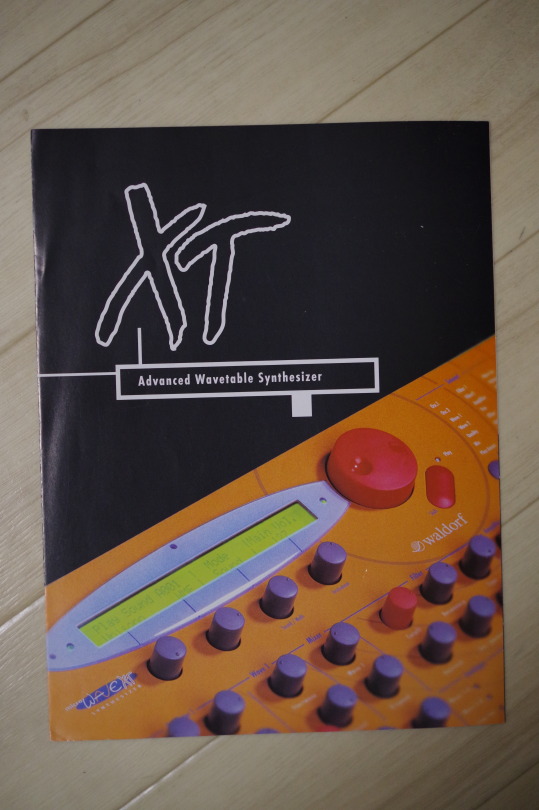
<海外シンセ興亡記 IV : waldorf microWAVE XT review>
●メーカー名
waldorf
ドイツのシンセメーカーのひとつ、旧 PPG の後継者が、waldorf 社。 PPG / waldorf は、ウェーヴテーブル音源方式を編み出したメーカーである。
PPG こと Palm Products Germany とは、その名の通り創業者 Wolfgang Palm(ウォルフガング・パーム)氏が '70 年代はじめからこつこつつくり続けていたアナログシンセを、組織として製造販売するようになった会社。

最初はモジュラーはじめ各種アナログシンセを出していたが、早くからデジタルオシレーターを開発、世にアナログシンセしかなかった '78 年には、おそらく史上初のウェーヴテーブルを使った PPG Wave Computer 360 を出している。これは8種類のウェーヴテーブルを持つデジタルシンセで、フィルターは無い! このウェーヴテーブルと同じものが、のちの PPG Wave 2シリーズ、waldorf microWAVE シリーズ、blofeld なんかに引き継がれているが、それを聴けば、タンジェリン・ドリームのアルバムで聴ける数々のデジタル音やサンプルめいた音色が、じつはこの Wave Computer 360 であることが分かる;
youtube
'81 年から始まった PPG Wave 2シリーズは、ウェーヴテーブルを増やして VCF/VCA を加えた機種で、これも DX7より2年も前に出た機種。

Wave Term なる専用ラックマウント・コンピューターを使うと、1波の波形編集やウェーヴテーブルのエディットが行えた。下の写真は改良型 Wave Term B モデル;

こうして ’80 年代には先端的なデジタル技術を駆使し、シンセシスト憧れの的として何百万円もする超高額機種ラインナップ Wave シリーズで一斉風靡したものの;

理想を追い求めた重厚長大かつ史上初のハードディスクレコーダー HDU(Hard Disk Unit)や;
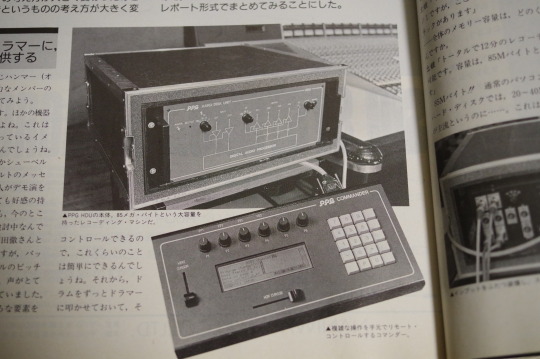
どんなシンセにも変幻自在となるはずの、幻のヴァーチャルハードウェアシンセ Realizer の開発にカネをつぎこみすぎたあまり

バグが止まらず崩壊、’88 年に PPG 社は解散した。北米キーマガには「Realizer that never realized.」と言われている。
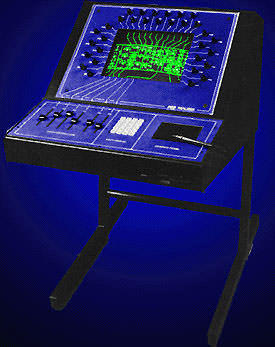
そして、翌年 '89 年に旧 PPG のエンジニアが再結成し、超個性派の新機種 microWAVE とともに驚きのデビューをはたした waldorf 社。
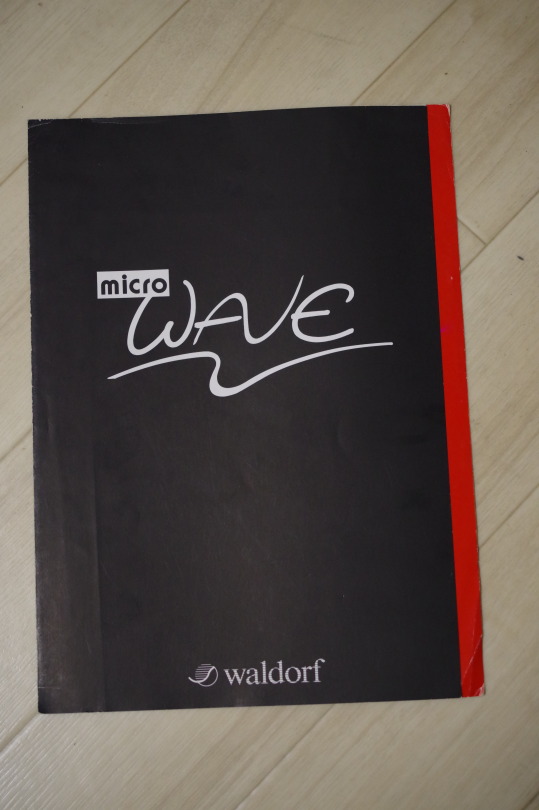
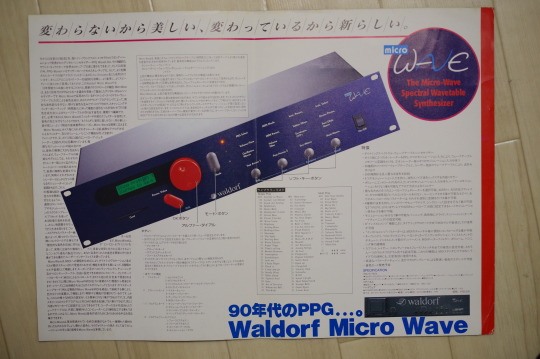
社名は、ハイデルベルグの近くにある小さな町、Walldorf ヴァルドルフにちなむ。

その後、120 万円もする巨大戦艦 The Wave を筆頭に
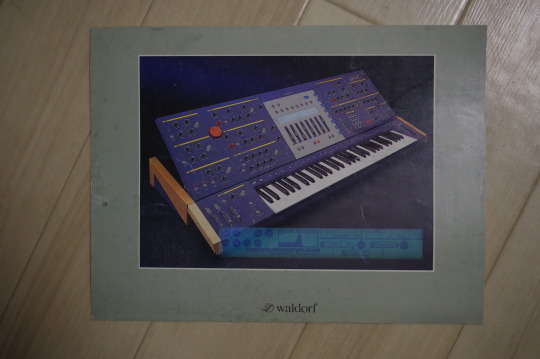
順調に microWAVE シリーズをはじめとする新製品をどしどし出していたが、アナモデの名機Qシリーズを発売したあと、しばらくしてから業績がふるわなかったらしく、2004 年には、いったん倒産したらしい。
しかし、その後、2006 年ごろからふたたびQシリーズの在庫一掃なのか分からん販売を再開し、それがフェードアウトするころ、2007 年になって正式に、不死鳥のようによみがえった新生 waldorf 社。
その新製品第1弾が、これまた衝撃の仕様をつめこんだ小さな純白の音源モジュール blofeld であり

2009 年1月には 49 鍵版の blofeld keyboard と

両機種ともにサンプルが読み込めてそのまま再生できる有償アップグレード・オプションが発表され、さら後にはボディカラーを漆黒に染め上げたブラックバージョンも限定生産にて発売された。

また blofeld keyboard が出たのと同じ 2009 年1月には、同社第2弾の新製品であり、同社初のソフトシンセ largo が発表された。
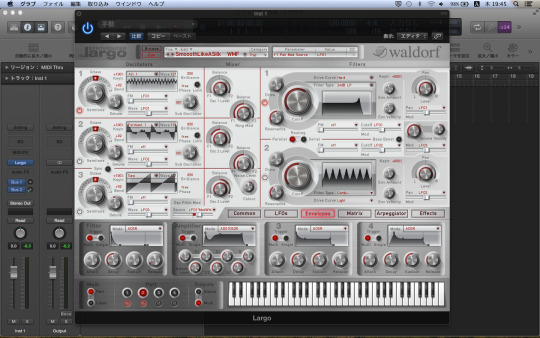
以降、新生 waldorf 社は、ハード、ソフト、アプリと、ふたたびさまざまなシンセを開発・販売し続けることになる。
iPad アプリ Nave

Quantum
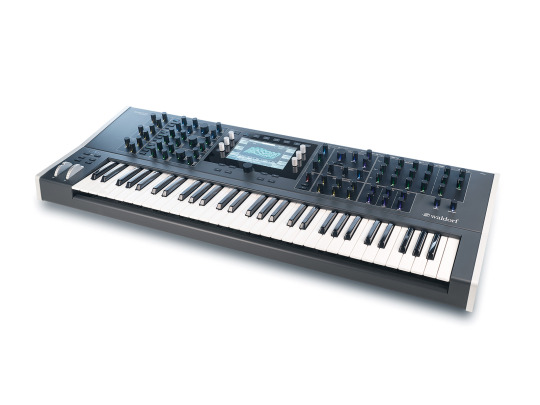
Kyra

他にも rocket や strechifett、zarenbourg などなどなどなど。
ここでは、waldorf 初代の機種である microWAVE シリーズから、さりげなくフルデジタルになることで、中興の祖となった機種 microWAVE II の派生機種 microWAVE XT を取り上げる。
●機種名
microWAVE XT '98 年発売 国内定価:約30万円
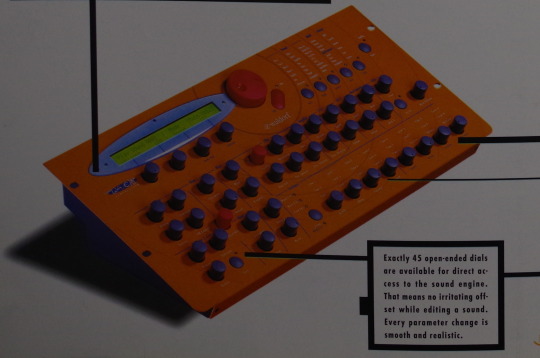
PPG の後継として設立された waldorf が、初号機 microWAVE を出したあと、それに続いて出てきた一連の microWAVE シリーズ最後の機種。waldorf が倒産する前の機種である。
フルデジタルシンセ音源モジュール。 しかも、5Uラック型かつ据置き型ほんでオレンジ色!
なお私が所有していたのは ver.2.11で、その後 version があがっていたはず。ネットで最新OSをダウンロード可能だったのは、今では当たり前すぎるが当時は斬新であった。
●音源方式
Wavetable Synthesis+フルデジタル減算方式 2基×ウェーヴテーブルオシレーター 1基×音色加工用マルチモードデジタルフィルター 1基×音色補正用マルチモードデジタルフィルター 1基×デジタルアンプ
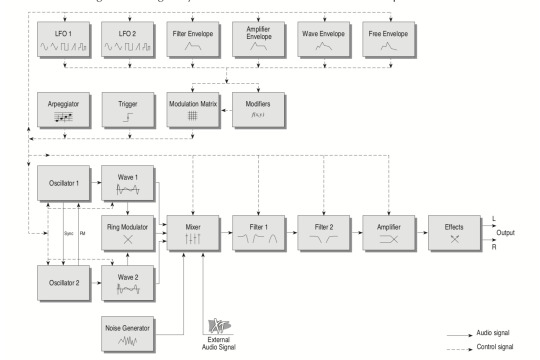
オシレーターだけで音色変化を創造できる、ユニークな方式。10 年代以降になって、この方式は数々のソフトシンセにて使われるようになる。PPG / waldorf は、その先駆者。
基本的には、64 倍音加算合成、ハードシンク、FM、ウェーヴシェイピング、サンプル波形などで1波を生成、波形が異なる1波1波を計 64 波つなげ、それを1ウェーヴテーブルとして1くくりにして扱う。普段はそのうちの1波のみを読み出して再生する。しかし LFO やエンベロープ、ベロシティ、あるいはノブ操作などで、読み出す1波を切替える事が可能。これがフィルターに依存しない音色変化を、もたらす。ちょうど、1コマ1コマ違う静止画が描いてあるフィルムを連続走査する事で、アニメや動画になるのと同じで、1波1波が異なる倍音構成の波形をつなげスキャンさせる事で、音色変化を生む。いわば、波形のパラパラ漫画方式。ランダム LFO などを使えばランダムに読み出す事も可能。
このウェーヴテーブル1個をひとつの音源波形として扱い、さらにこのウェーヴテーブルが数~数十個搭載したのが、旧 PPG ならびに waldorf の Wave シリーズ・シンセである。 microWAVE XT には、以下のウェーヴテーブルがプリセットされている;
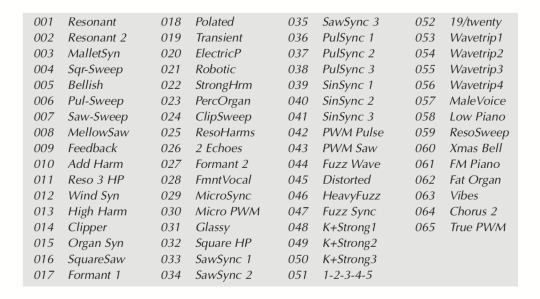
ウェーヴテーブルにアサインされている個々の1波は、エディターソフトで波形編集できる。同社の The Wave という機種は、自力で波形創成すらできた。
エディターソフトで波形編集できるのは倍音加算合成による音源波形のみで、他のシンセシスによるものはメーカーが専用機器で合成されたものを音源波形メモリーに焼き付けているため、エディットはできない。これは Waldorf 社に、直接、英文メールで問い合わせて分かった。
プリセットされているウェーヴテーブルは、個々の波形が、隣同士で全く異なるものもあれば、徐々に倍音構成が変わるように仕組んであるものもある。金属波形ばかり集めたウェーヴテーブルなどは、特に面白く、フィルターでは不可能な、不思議な音色変化が得られる。 しかも microWAVE XT にてウェーヴテーブル上のインデックス(読み出しポイント)を変調する EG は、ADSR を超えた多ポイントのものであり、これはのちの Largo や Nave といったソフトシンセでは得られない貴重な高度な仕様であった。
なお、旧 PPG / Waldorf の慣習として、各ウェーヴテーブル最後の3波だけは、どのウェーヴテーブルも同じ三角波、矩形波、鋸歯状波がアサインされている。
こうして創られたオシレーターからの出力は、デジタルのフィルター、アンプを通り、つまり通常の減算方式で加工される。アナログフィルターを採用していた PPG や初期の Waldorf microWAVE シリーズと違い、microWAVE XT は、フルデジタルである。
●同時発音数
10音
これでも当時の VA としては多かったのだが、さらに 30 音までの拡張サービスがあった。基板を交換だか追加だかをするので有償である。
10 音ポリで8パートマルチになるのは、この当時の DSP シンセとしては普通として、8パート個別に 16 ステップ・アルペジエイターが走らせることができるのは、じつはヤマハの特許を侵害しているのだが、ヤマハにしてみれば捨て置け捨て置けで放置していたらしい。彼らが叩くのはK社みたいな、より大きな同業他社だけ?
●内蔵エフェクトの性能と傾向
ステレオ1系統。ひととおり、空間系、変調系、歪み系すべてあり、かかり具合も良い。ちゃんとエディットもできる。
マルチ音源として8パート構成にできるので、そのとき初めの3パートはシングルでのエフェクトをそのまま生かす、残りのパートはコーラスに限定される、とか、いろいろ当時なりにがんばっていた。
グルーヴ・ダンス指向なのか、ディレイタイムが、音符と BPM の組合わせでしか表示されないのには、ちょっとびっくり。つまり、BPM = 125 での八分音符、という具合。 謎のギターアンプ・シミュレーターもあって、いくつかのキャビネットタイプが選べるあたり、ただのイコライザーかと思いつつも、ここまで変な連中の考えることだから、ひょっとしてひょっとするのか、この時代にしてすでに DSP の余力で極超初歩的な物理モデリングの先駆者的なる不可思議な演算でも行っているのか?
●内蔵波形、プリセットの傾向
64個のウェーヴテーブルを搭載。 さらに1ウェーヴテーブルあたり、64個の波形を搭載。 リアルな音よりも、抽象的な音のほうが得意。
搭載されているテーブルは、旧 microWAVE と同じ。なんと旧 PPG Wave シリーズの波形を全て搭載。フルデジタルだから、いわば「バーチャル PPG しかもハードシンセ」である。
下記サイトに、搭載されているウェーヴテーブルを時間軸上で FFT 分析したグラフィックスが掲載されている;
http://unofficial.waldorf-wave.de/wavetable.html
すごい、さすがフィルターだけでは表現しきれん表現力、音源波形のオンパレード。
エンジンそのものは旧 microWAVE よりも進化しており、例えば旧 microWAVE より波長の長い波でも記憶可能。また波の後ろに、同じ波を点対称にひっくりかえした波をつなぐことで、複雑な波形を作成可能。さらに、64個ある波形の全部を埋めなくとも、任意の範囲の両端となる2波のみ入力すれば、あとは microWAVE XT が、中間波形を演算で算出・補完してくれるインターポレーション機能すらある。でも自力ではそんな波形編集はできない。自力で波形編集できるは、かの巨大シンセ The Wave のみ。本機の場合は外部エディターが必要。 しかし後述するが、プリセットされたウェーヴテーブルだけで、十二分に楽しめる。
A/B の2バンク各々128音色あるプリローデッド音色は、生産された時期によって違う。かなりひんぱんに内容を改編していたようで、時期によって全く異なる上に、いくつもの版まである。以前はメーカーサイトからダウンロードできたが、今は?
私が持ってた版は、最も広く普及したエディションらしいのだが、相当にヲタなプリローデッド音色ばかりあり、テクノや SF 映画などにヒントを得た音色が満載。例えば「MCP」という名前の音色があり、これは映画「TRON」の超マイナーな効果音そのまんまなので、これまたマニアックに笑える。また内蔵アルペジエイターによるダサいスレスレのユーロ・テクノなバッキングパターンは、分かる人には爆笑。タンジェリン、ジャール、ヴァンゲリスなどが好きなら、それらをニヒルに真似たネタにもニヒルに笑えるであろう。

●エディットの自由度と可能性
2オシレーター構成だが、両方とも同じウェーヴテーブルを共有する。ただしウェーヴテーブル内の、どの波形を再生するかは、個別に決定可能。
ウェーヴテーブルによる音色変化は、実にけったいで、クラフトワークのヴォコーダーのように「アインス・ツヴォオオ...」とドイツ語で数を数えてくれる(と錯覚する)ものすらある。先述のとおり、徐々に波形が変わってゆくテーブルもあれば、何の拍子か突発的に音色が変わるテーブルもある。特に旧 PPG 商品から引継いだテーブルには、わざわざ当時のバグを再現したのか、突拍子もなく劇的な変化をするものがある。またかつて定評があったサックスの波形もあり、これは「ほぅ。ま、なるほどねぇ」と隔世の感あり。その他にも FM 音源に似ているがもっと太い波形や、高次倍音がギシギシ出ているものも多く、これだけで充分すぎるほど個性的、買う価値はある。
先述のとおり、ウェーヴテーブルをスキャンする EG は多ポイントのものであり、のちの waldorf 機種よりもすぐれたアドバンテージとなっている。逆に言うと今の機種では役不足なところでもあり、ここは改善していただきたい。
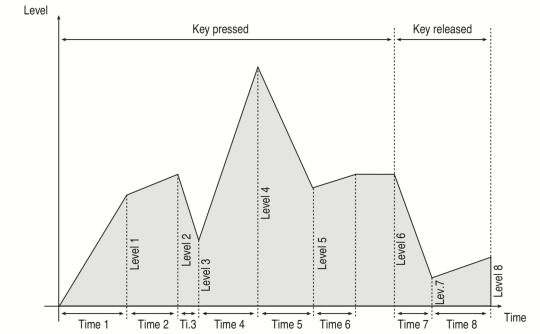
リング変調もクロス変調もハードシンクもできる。けっこう汚い音になるのがまた良い! 10音ポリなので、ユニゾンにすると JUPITER-8に近似した素晴しく暴れた音になる。しかもユニゾンにすると、ヴォイスごとにディチューンできるのは当前としても、ディ・パンニングまでできるのは初めて見た。つまり、ヴォイス毎に適当にパンニングを散らかせてくれるのである。もともと倍音が気持ち良いので、なお良い。
オシレーターのピッチを 128ft にまで落とせるのは、なかなかない。まぁ音が破綻するのだが、それでもええやないかい、音創りや。
旧 microWAVE の方が音が太い、と言われるのを見越していたらしく、わざわざ D/A コンバーターでの量子化ノイズを流出させることも可能。当時はビット落としなんてそんなに無かったから斬新。ビット落としの先駆者なんて、KORG DSS-1 くらいかなぁ? さらに D/A の演算を意図的にアホにする事も可能。出力がクリップした場合、そのまま頭打ちでサチって出力するのか、あるいは符合だけ反対にして出力するという安もののコンバーターの動作すら再現してみせたりするのか、選ぶことができる! これはささやかながら、凄い。

このころからお約束になってきた外部音声入力も、標準装備。
デジタルフィルターも滑らかで、非常に充実。様々な特性のローパスやハイパスは無論、Oberheim Xpander のごとくオシレーターでカットオフ周波数を FM 変調できるフ��ルターや、WaveShaper を通してからかかるフィルター、果てはビットクラッシャーとレート・リデューサーのあとにフィルタリングするものなどなど、10タイプも装備。 さらに第ニのフィルターがあり、これは6dB/oct.という緩やかな特性を持った LPF/HPF 切替式で、補正フィルターとも言うべきもの。
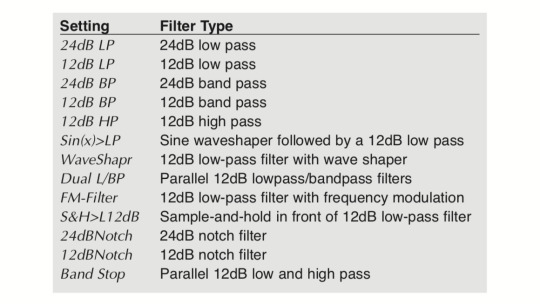
各フィルターの効き具合も、中々にアナログ的。レゾるところもばっちりだが、ただ、カットオフを絞りまくっても少し音がもれるところは、ちょっと残念。
エンベロープがループできるのには拍手。LFOも非対象波形になるまで歪めれるので、普通の鋸歯状波からも、いろいろバリエーションが楽しめる。
仰天するのがモジュレーションマトリクスで、この当時にしてすでに 30 以上のソースと 30 以上のデスティネーションとを、16 本のパッチケーブルで接続するに相当。おまけに4基のモディファイアを使うと、ソースとデスティネーションの間に、不可解な数式を組み込むことが可能。これは、かつての Kurzweil K1000/1200、現在のユーロラック・モジュラーなどにあった、正体不明の関数モジュールと同様の機能。モディファイアの出力を別のモディファイアへ入力できて、もはやコメントしがたいほど壮絶。ベロシティ最大値でのみリング変調を作動させたりできる。
変な16ノート・アルペジエイターは、ユーザー設定可能。プリセットパターンが、なんともヨーロッパ人ごのみの、ずんどこずんどこパターンばかりで、そのまま日本人が使うとごっつダサくなりそうなのには笑える。そんなことよりあっと言う間にジャン=ミシェル・ジャールが出来る。あなたもジャール、気分はもう「磁界」。
使い勝手は、ツマミごこちのいいツマミたちのおかげで非常に簡単。値段に負けてmicroWAVE II にしなくて、ほんとうに良かった。このトルク感! これですよこれ! これこそ楽器ですよ楽器! 触り心地! フロントパネルの上 2/5 は microWAVE II となんら変わりなく、気分でどちらのエディット方法も可能。特にウェーヴテーブル切替ツマミと、カットオフのツマミとが、赤く着色されているのは、実に感慨深い。カットオフ同様、テーブル切替がキモなのだ。
ところで私のはハード自体が古いバージョンで、ツマミがずん胴である。後期のは上半分がやや細くなった改良型で、同社のQ等に採用されているのと同じもの。こちらのほうがツマミの間隔が開いていて使いやすそうではあるが、さりとて私自身は不便を感じた事が無い。ごっついドイツな巨漢むきの改良か?
またツマミは果てしなくグルグル回るエンコーダーで、従ってパラメーターの変化幅も大きくとってあり、微調整もしやすい。そのかわり必ず相対値操作となるので、絶対値でのエディットは不可。演奏中での狙った演出時には、ちょいと注意しておいたほうが良い。
●拡張性
ネットで OS をダウンロードできた。わざわざ URL を LCD ��表示してくれる。この当時、これを見て「ついにそんなネット時代になったか!」と思った。
30音ポリに増大してくれる有償サービスがあった。
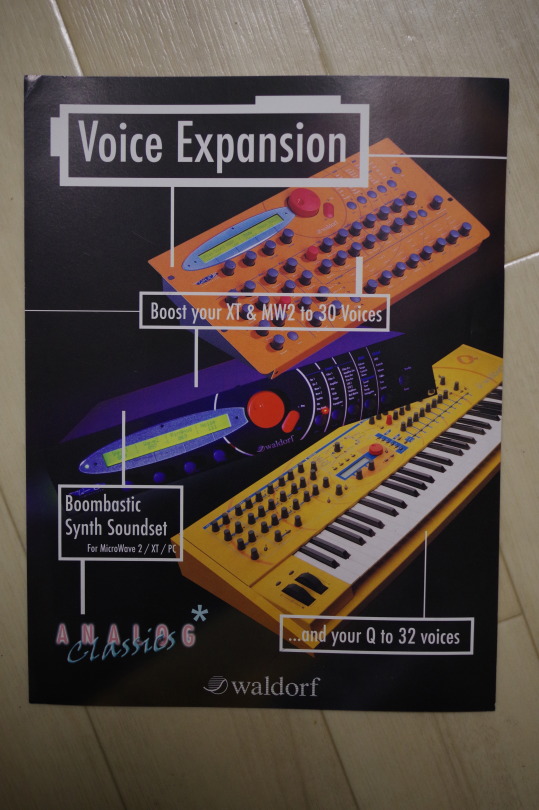
どこか中途半端な木製サイドパネル(?)のようなものもあった。ラックマウント用の「耳」に装着するのだが、長さがラック高の2/3くらいしかない。ちょっとこれ説明不能。
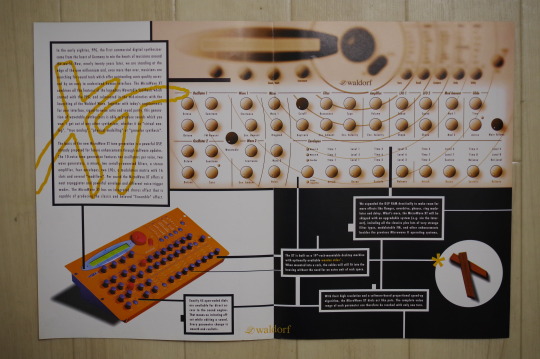
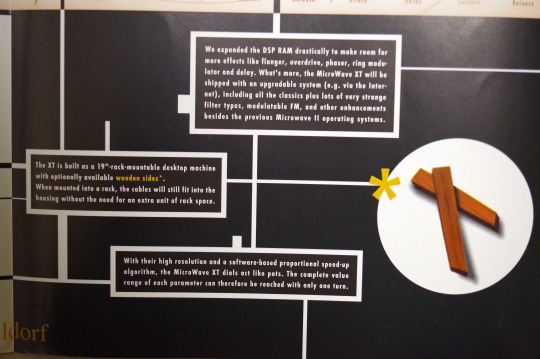
●あなたにとっての長所
もちろんこのマニアックなウェーヴテーブルの数々。これだけでも買いなのに、さらにディープでモジュラーなシンセシスが可能、EG も多ポイント、しかもエフェクトとアルペジエイターまでサービスされて、これで満足しないはずがない。
オレンジ色がまぶしいフロントパネルもよく見れば、意外にシックな色合いのスェード調。渋くて良い。海外のギアには、センスが理解できない異文化ものが多いが、これなら私も好きだ。良く知らないがディーゼル機関車的な色彩感覚なのか、まさにヨーロッパの鉄道などのような、シックにくすんだカラフルな工業製品感覚。
パワースイッチが他のボタンと同じデザインで、こりゃ危ねーな-と思うも、そこは考えられていて、稼働中に長押しつづけないとオフにならない仕組み。しかも押しつづけていると
"Switching myself off"
とキュートなメッセージが出て、そのまま10からゼロまでカウントダウンが始まる。カウントダウン中にスイッチから手を放すと、電源は切れないからセーフ。
ランダムエディットが可能。実行キーを打鍵するたびに、勝手にマシンがランダムにパラメーターを設定。サイコロをふるがごとくに音色自動的に創成。最低でも10回に3回は、絶対に面白い音になる。ただし使える音かどうか���別。ったって使いにくい効果音になっても構うものか。おもろい音ならそれでええ! でや、なんせ私には楽音と効果音の区別がつかんのだ!
microWAVE XT の英文マニュアルは親切で、関数モジュールといえども分かりやすく図解されているので助かる。
●あなたにとっての短所
パワーオフ・カウントダウンが目にも止まらぬ速さで完了するので、正直あんまり安全設計とは言えない。やってくれるぜ Waldorf! おかげで、さきほどの
"Switching myself off"
という、おちゃめなメッセージを読み終わって笑うと同時に電源が切れる。これは、ヨーロッパ人ならではの、毒の効いたブラックユーモアやもしれぬ。
あまりにランダムエディットが優秀なので、自分で音を創らなくなった。いかん。
古くなってくると、ポップなオレンジのスェード調なフロントパネルのペイントがぼろぼろ剥がれてきて、シルク印刷も一緒に剥がれ、しまいには操作しようにも、なにがなんやら分からんよーんなる。
とにかく高価だ。しばらく金欠でうなっていた。

●その他特記事項
某店員などは 「こんなもの買う人そうそういませんよ」 と、真実とはいえ失礼な事をのたまった。だからその店では買わなかった。ばーか。
さて、microWAVE XT の特徴を一言で言うなら、マニアックな仕様と値段なるもそれにあるまじき軽快さ、そしてトドメの手触りのよさであろう。
'80年代にドイツから覇をとなえた PPG といえば重厚長大、大艦巨砲主義の権化のようなメーカー。1986 年にニュースがひろまった幻の Realizer なんか、今日のバーチャルシンセの走りですらある。

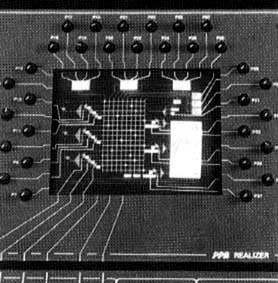
実際に彼らが夢想したことは、30 年以上たった 2008 年の年末ごろに、Arturia Origin が実現したわけで;


‘80 年代にしてすでになんでも実現できるトータル・システムを目指したがっていたところは、ドイツ人気質なのか、則ちまるでメルセデスのごときドイツ完璧主義なのか? 卓越したマエストロが生み出す匠の世界。そう言えば Creamware Pulsar は、なんでもコンセプトを真似したがる妙なメーカーであったが、PPG や Steinberg と同じく、トータルなシステムをめざしていたところは、通じるかもしれない。
それがいったん倒産し、やがて Waldorf となって復活。最初は小さな microWAVE にはじまり、「世界三大発明」として ・日本の盆栽 ・マクドナルドのハンバーガー ・そして microWAVE とが載った不思議な宣伝を打つ。
それがその後、またしても重厚長大路線に走りかける。なってったって The Wave。採算度外視にも、ほどがあると思われた名機。カラーバリエーションや、76 鍵モデルもあった。
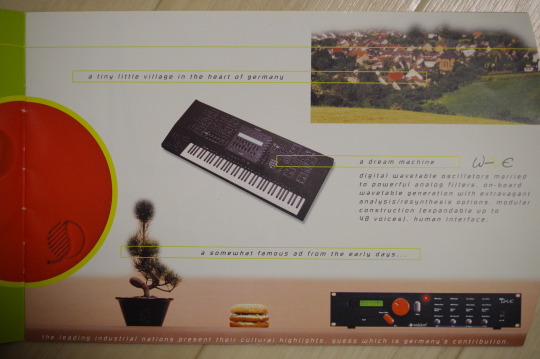
その巨大戦艦 The Wave、またの名を waldorf WAVE.それはいかなる機種であったか?

そもそも The Wave は受注生産であり、日本には十台くらいしか無いと言われた。受注生産だけに、かえって柔軟に対応できたらしく、標準の青色の他に、シャア専用みたいな赤いやつ、Qみたいな黄色いやつ、精悍な黒いやつがあり、さらに 76 鍵版や、同時発音数を拡大するサービスも当時はあった。
その定価は 120 万円。

先述した microWAVE XT と似ていて、1波1波の波形は 64 倍音加算合成、FM 合成などで作成。microWAVE などと違うのは、すべて自力で波形生成できること。
びっくりするのが The Wave における1波をつくるための FM 合成で、8オペ1アルゴリズムという変態ぶり! しかも各オペレーターのパラメーターは、フリケンシーと出力レベルのみ! EG 無し! これは1波の波形しか生成しないために、こんな変態な仕様にしたらしく、これはもはやオペレーターというよりただのサイン波オシレーター。
して、アルゴリズムの形は:
Op1 → Op2 + → Op3 Op4 → Op5
Op6 → Op7 → Op8
という、二系列のタワーになった、6モジュレーター2キャリア構成。
他にも波形ハンドドローイングや、フォルマントフィルターをつかって波形生成したり、サンプル、それも、いにしえの Sound Designer I フォーマット(SDII では無い!)ないしは ATARI コンピューターの Avalon フォーマット(もはや化石!!)ないしはサンプル・ダンプ・スタンダードで取り込んだ PCM サンプルを、FFT / 逆 FFT で分析 / 再合成するというリシンセシスまで可能!
そのリシンセシスには2通りあり;
・1波のみの波形を生成するためにフォルマントを読み取って、それを全鍵域にあてはめる方式

・1波どころかウェーヴテーブルを丸ごと一気に生成すべく、フォルマントは読み取らず、そのかわりフレーズサンプルをまんま時間軸上の 64 ステップにぶったぎってウェーヴテーブルを生成する方法
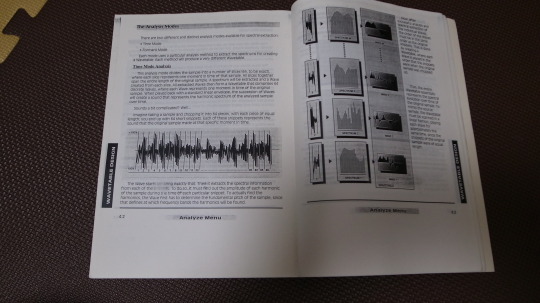
とがある。
後者の場合、言葉をしゃべってウェーヴテーブルにし、和音を押さえると、各構成音のフォルマントは崩れる代わりに、フレーズのテンポが同期するので、のちに Roland が出した VariPhrase 技術を原始的にしたようなことが実現できていた。エンソニック EPS 16+でも、1波ループを設定し、モジュレーションマトリクスを使えば、似たことができましたね。このあと 2000 年1月のナムショーにて Roland が実際に VP-9000 として史上初のバリフレーズ機を発表したとき、waldorf の社員が見にきて「僕たちもこれをめざしていたんだよ」と言ったという。彼らなりのバリフレーズが実現できていたら、さぞかしおもろかったやろうね!!!!!
The Wave のすごいところはこれにとどまらず、さらに、すべての波形において2つの波形を加減乗除できる。しかもそれは、1波を構成するX軸(時間軸)目盛り1つずつのY軸(振幅)の値に対し、加減乗除する。言い換えれば、1波を構成するサンプルデータひとつずつの振幅を加減乗除するということ。特にシンセシスで初めて見るこの除算、興味深い。
これで1波の波形をいくつかつくって、それを 64 波つなげてウェーヴテーブルにする。しかも、microWAVE XT 同様、64 波すべてを作らなくとも、いくつか作って適当な場所に放り込めば、あとはその間の中間波形は自動補完機能にて自動生成される。
これら音源波形は、アナログ回路による4 pole レゾナンス付き LPF と、これもアナログ回路による2 pole レゾナンス無しの HPF とで加工できた。その LPF と HPF とは、直列に接続するとバンドパス・フィルターとなり、並列に接続するとノッチすなわちバンドリジェクト・フィルターとなった。
また、EG や Modulation Modifiers と呼ばれるものにマクロ機能があり、これにより本来だとモジュラーシンセなみに結線しなければいけないモジュレーション系統の操作を簡易にしていた。たとえばモジュレーションホイールでピッチ LFO かけるためのマクロ、とかあった。
液晶が横長の表示板なんで文字表示だけかと思ったら、じつはグラフィック表示できる代物。しかも非常にふんだんに分かりやすいグラフィック表示をたくさん取り入れ、使い勝手も良い。ブロックダイアグラムみたいなグラフィック表示すらある。操作性の良さは、waldorf の象徴にすらなった、でっかい赤いレッド・ノブだけではない。

サンプル波形からウェーヴテーブル自作できるところといい、グラフィック波形表示などといい、The Wave は PPG Wave 2シリーズに、WaveTerm をぶち込んだような仕様ですな。当時そんなことまでできる処理能力を誇った単体機は他になく、これはもはや波形コンピューター。旧 PPG の Wave Computer 360 の名をほうふつとさせる怪物であった。
なお、OS は、なんとフロッピーディスクで供給! かつてエンソ EPS やイーミュ Emax、ローランド S-50 やなんかに採用されてた方式。しかも起動が待てないせっかち屋さんのために OS ROM というのも別売されていた。内蔵記憶媒体として HDD も搭載。
どうやら The Wave は、ウォルフガング・パームさんが、やりたかったことをすべて盛り込んだような超弩級変態シンセらしい。すごいですなぁー! 倍音加算も FM 合成も自力で可能なあたり、幻に終わった PPG Realizer の再来に近い部分すらある。waldorf 初号機 microWAVE が成功したあと、The Wave を開発するにあたり、とことんやりたいことをやりつくし、その成果からきっと microWAVE XT のような縮小版が誕生したんでしょうなぁ。
だいたい 78 年に Wave Computer 360 を出した歴史ある彼らにしてみれば、技術的な面のみならず、エンソニックの TransWave や HyperWave も、コルグの Wave Sequence にしても「元祖は自分たち PPG / waldorf なんだ!」という思いもあったのかも。それでご本家として「20世紀最高のシンセ」という宣伝をしたのかも。まぁ、憶測の域を出ませんが。

しかし巨艦 The Wave を世に送りだすことができたおかげで、Waldorf 社は過去の呪縛から解放されたのであろうか。また、性能の良い DSP が出てきたのであろう。microWAVE XT は、ヲタな仕様にもかかわらず、軽快ですらある。それどころか過去の重厚長大主義から解き放たれた、不思議なポップさがある。PPG 創業者ウォルフガング爺が社を去ったという事と関係があるのかは、知らない。とにかくマニアな機種なのに、受ける印象が以前ほど硬派でなく、良い意味で一般性が、ポピュラリティが、増したように感じる。
まず発音数の増大やエフェクトを積んだ事もあって、スペック的に初代 microWAVE ほどストイックな印象を受けなくなった。さらに親しみやすいその使い勝手は、軽快さに拍車をかけているようだ。
そしてこのデザイン。価格の高さはおそらく零細企業なのだから仕方ないとしても、このあたたかい太陽系のような奇抜なデザインは、明らかに新生 Waldorf のポップで軽やかな感覚を象徴する。同じくテーブルトップ型の音源モジュールである JP-8080 や NOVA と、ぜひ並べてセッティングしてみたい。音も色彩豊かなのは、もはや言うまでも無い。しかも見かけだけでなく、使い勝手も良ければ、触り心地も絶妙。いつまでも、いじりつづけたくなってこそ、真の楽器と呼ぶにふさわしい。
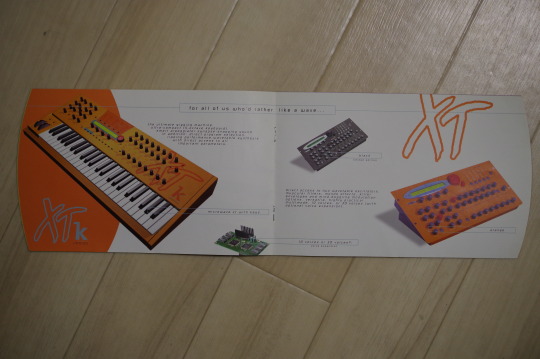
かつて同社からは、Gekkoという、ヤモリから名を借りた、カラフルな「まが玉」のごとき形の、単機能の MIDI デバイスも発売されていた。

マニアな世界に有りがちな暗い閉息感や厳しい求道感とは、ひと味もふた味も違ったツウごのみ仕様かつ軽やかでオープンで色彩豊かな商品展開を、筆者はひそかに期待していた。

この後、いったん Waldorf は倒産してしまうが、ゼロ年代半ばすぎあたりからぼちぼち復活。microWAVE シリーズは姿を消したが、当初Qシリーズを継続して販売し、その後、かつてなく小さいボディに凝縮されたヲタなウェーヴテーブルシンセ blofeld、同じく小さく取り回しがいいながらもヲタでニッチな周波数分周方式のストリングスモジュール Streichfett などが出ることになる。そして、Nave のようなソフトやアプリも軽快。ネット時代の進展とともに、モバイルギアがよろこばれると、それに乗ったポップで軽妙洒脱なガジェット的な機種がたくさんでてきた。

blofeld という機種名は、映画「007」シリーズの主人公ジェームス・ボンドの宿敵たる悪役、ブロフェルド総裁にちなんだものであり、blofeld 専用サンプルエディターソフトの名前 SPECTRE は、ブロフェルド率いる悪の秘密結社の名前スペクターをそのまんま持ってきたという、遊びごころ満点のネーミング。かつて活躍した映画評論家、淀川長治は、例の名調子でブロフェルド総裁のことを「ま~この人、悪い人。恐ろしいですね~。」と言っていたらしい。
そのため、blofeld が新生 waldorf からデビューしたときのネット広告では、ブロフェルド総裁に扮したゲーハーおっさんが blofeld を抱え、にこにこしながら映画でトレードマークともなっていた愛する猫とともに写っており、ドイツ訛りの英語で「この、ちんけさいざー、たまらんええぜよ」みたいな宣伝コピーが書かれていた。
凶悪な音が出るシンセに、ふさわしいネーミングであり、宣伝戦略。
This one got my name on it
For many yearss I trrick and tweek all ziss syntesizing maschinery to produce hyooch aural vibrationss. Bat zey are all not capable to produce a sound so powerfull and faehht like I need for ze big explosionss.
Zey are so big and so many zat I cannot take on the journeys, you know? My very german Waldorf syntesizing scientists heff now developed a new sintesizing maschine viz ze power of many, many maschines inside! It is so strong, I cannot believe. My enemies vill be very surprised, yes! Hoeh hoeh.
訳してもいいんですけど、ドイツ語訛りの英語を訳すむずかしさと、それをドイツ人自身がネタにしている宣伝をそもそもどう訳したものか考えあぐねてて、どうも。
そしてそれらはやがて、2020 年を目前にして Quantum や Kyra といった、みたびの巨大戦艦、三度目の正直となって、それでもまだ性懲りもなく世に送り出す。 同じく巨大戦艦たる moog one も出ている今、時代は、みたびのフラッグシップ!

しかも今度こそ、仕様が大規模である一方、やはり操作性や使い勝手のセンスは軽快、軽妙洒脱である。
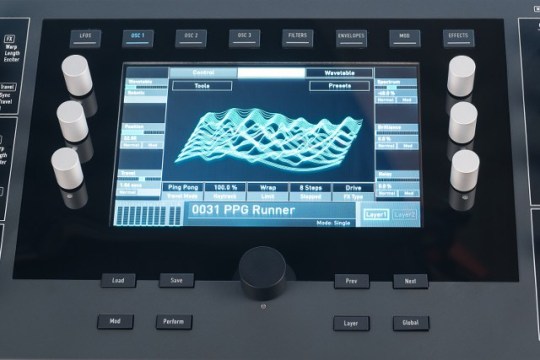


新生 waldorf には、これからもディープな機種を、それでいて軽くも愉快なセンスのデザインに満ちた開放的な感覚の、それも手触り感にすぐれた真の楽器を、これからも望むばかり!
その一方で、ウォルフガング爺は、自分だけで個人商店 PPG をふたたび立ち上げ、ウェーヴテーブルを彼なりに発展解釈した TCM - Time Corrected Sample などを開発、そのテクノロジーを利用したソフトシンセやアプリシンセを出してきた。あまりにも難解ヲタすぎて理解できないのだが、音のキャラを因数分解し換骨奪胎するウェーヴマッピングは、オブジェクト指向で楽しい。
老将が繰り出すソフトシンセ。
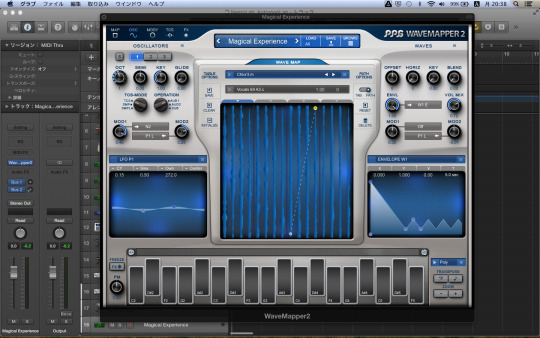

その老将パーム爺も、2020 年に 70 歳になるとあって、ついに引退を宣言。 つくってきたプラグインシンセは、他社に譲渡される。かくして、電子楽器あけぼのの時代を知る歴史の証人が、また一人、視界からフェードアウトするのだが、しかし自分が存命のうちにビジネスをやめてご隠居できるというのは、ひょっとしてパーム爺ご本人にとっても本望で幸せなことなのか? ここに、彼のサイトにあった原文を紹介;
Important announcement
Dear Customer,
after 50 years of creative work in the field of sound synthesis I decided to stop doing business. I've been thinking about this step for some time now, especially since I've turned 70 this year. Therefore, I am very happy to have found a competent company in Brainworx Audio GmbH that will take over and continue my products and ideas.
I would like to thank you for the support I've received over the last six years. PPG VST plug-ins and iOS apps are no longer available for purchase. We will continue to provide downloads of your previous plugin purchases until end of 2020.
However, we do not recommend updating the hosts or the operating systems, as we cannot guarantee that our products will still run perfectly.
Customers of PPG plugins will receive a mail from SendOwl, which gives more infos on how to connect to Brainworx.
The future of the iOS apps has not been decided yet.
Thank you again for your support.
March 2020, Wolfgang Palm

もはやプラグインのゆくえという、やぼなことを聞く雰囲気もゆるさない、歴史の重みだけが、ずしっと。
Copyright (C) 2006-2020 Nemo-Kuramaguchi All Rights Reserved.
Revision log; First edition posted on Mar 8th, 2020
4 notes
·
View notes
Link
#embrace#laurensarahhayes#free improvisation#noise music#noise#live electronics#ai#machine learning#machine listening#synthesis#pulsar synthesis#microsound#bandcamp#music#electronic music#experimental music#superpang
0 notes
Photo

https://pwgen20.bandcamp.com/releases
My track “Timeline” is on this compilation:
Pulsar.scramble
This incremental compilation features music composed with The New Pulsar Generator (nuPg) program with and without the aid of additional effects and processing. New artists will be added to this over time. The New Pulsar Generator (nuPg) is an interactive program for sound synthesis developed in SuperCollider 3 (SC3) programming language by Marcin Pietruszewski. The nuPg program produces a form of synthesis called pulsar synthesis (PS). The technique of PS operationalises the notion of rhythm with its multitemporal affordances as a system of interconnected patterns evolving on multiple timescales. The technique generates a complex hybrid of sounds across the perceptual time span between infrasonic pulsations and audio frequencies, giving rise to a broad family of musical structures: singular impulses, sequences, continuous tones, time-varying phrases, and beating textures. www.marcinpietruszewski.com/the-new-pulsar-generator
1.17percentbatteryjazzsolo / Eric Frye 02:51 2.Timeline / Ellen Phan 02:25 3.SC_200111_000852 / Farmers Manual 03:04 4.oyYO oyYO @reverss / RM Francis 03:21 5.Anger_Management / v93r 03:24 6.Rubber Raccoon / EVOL 07:56 7.I_yyy_lcU / Victor Moragues 06:13 8.249534301465495853710507 / Joe Gilmore 01:03 9.sieveSequence(000110100110) / Marcin Pietruszewski 03:28 10.Surround Repair / Ian M Fraser 01:26 11.936153381827968230301952 / Joe Gilmore 03:29
1 note
·
View note
Text
Formation of Mass-gap Black Holes from Neutron Star X-ray Binaries with Super-Eddington Accretion. (arXiv:2205.10717v1 [astro-ph.HE])
Electromagnetic and gravitational wave observations indicate that there is dearth of compact objects with mass $\sim 2.5-5~{\rm M_\odot}$. This so-called "mass gap" may be linked to the supernova explosion mechanisms that produce neutron stars (NSs) and black holes (BHs). However, the existence of a few mass-gap compact objects, some of which have been confirmed to be BHs, poses a challenge to the traditional theory of black hole formation. In this work we investigate the possible formation channel of BHs from accretion-induced collapse (AIC) of NSs in X-ray binaries. In particular, we consider the influence of super-Eddington accretion of NSs. Recent observations of ultraluminous X-ray pulsars suggest that their apparent luminosities may reflect the true accretion luminosities of the accreting NSs, even exceeding the Eddington limit by a factor of $\gtrsim 100$. Thus, NSs accreting at a super-Eddington accretion rate may rapidly grow into BHs in intermediate/low-mass X-ray binaries. Based on the super-Eddington accretion disk models, we have investigated the evolution of NSs in intermediate/low-mass X-ray binaries by combining binary population synthesis and detailed stellar evolutionary calculations. We show that super-Eddington accretion plays a critical role in mass growth of NSs, and the final masses of the descendant BHs are heavily dependent on the NS magnetic fields, the metallicity of the donor star, and the bifurcation period of the binaries. AIC of NSs may account for some of the observed mass-gap BHs like GRO J0422+32. We also present the parameter distributions of the potential mass-gap BHs in a Milky Way-like galaxy, and point out that future space-based gravitational wave observations may provide important test of or constraints on the formation of mass-gap BHs from the AIC channel.
from astro-ph.HE updates on arXiv.org https://ift.tt/mWtpTlE
0 notes
Photo

Keroaän - Pulsars in Rhombus Form (nada21) Pulsars in Rhombus Form is the result of a real-time generative music agent utilizing machine listening and pulsar synthesis (Roads). For this recording, a custom built 8-voice pulsar synthesis engine takes its compositional cues by listening to the album Planisphærium by sci-fi technical death metal band Wormed (ES). The program performs with no human intervention whatsoever.
2 notes
·
View notes
Text

Pulsar.scramble vol. 3
3 Presets: 1 Preset, 2 Preset, 3 Preset
The final volume of the Pulsar.scramble series. All tracks are composed using pulsar synthesis, an advanced form of particle synthesis used to generate trains of sonic particles. Its output ranges from singular impulses and sequences to continuous tones across multiple perceptual timescales. Most of the material presented in this series uses the New Pulsar Generator (nuPg) software designed by Marcin Pietruszewski.
released April 2, 2021
0 notes
Text
Single review: Chase Baird “Pulsar”(Outside In Music, 2020)

Chase Baird: tenor saxophone, EWI; J3PO: Fender Rhodes, synthesizers; Dan Chmielinski: Moog bass; Steve Lyman: drums.
Saxophonist Chase Baird (now burgeoning guitarist and singer-songwriter!) made waves last year with his most fully realized composition and band leader statement yet A Life Between (Sounds A Bound) featuring an all star band with Brad Mehldau, Nir Felder, Dan Chmielinski and Antonio Sanchez. Another one of Baird's passions is electronic music and synthesis; something explored on his brand new single “Pulsar”, featuring his tenor and EWI, Julian Pollack (also known as J3PO) on piano, Fender Rhodes and synthesizers, Dan Chmielinski on Moog bass and Steve Lyman on drums. The track, initially conceived as an electronic dance oriented piece becomes more of a hybrid with jazz improvisation in the center. “Pulsar” paints a broad post futurist portrait of the unknown, and discovery. J3PO's ring modulated Fender Rhodes speak of this uncertainty of a new world, visions in the listener's mind reminisce about early 80's videos and space and technological innovation as juicy, throbbing Moog bass wiggles it's way into the open, minimal space. Triumphant chord progressions signal the delight of exploration and signs of life as astronauts explore the new world. Baird's saxophone and J3PO's acoustic piano in tandem, stake claim boldly of this new world, Baird's EWI euphorically states the anthemic chorus while Lyman all the while is slicing the beat different ways acoustically emulating the programming of Aphex Twin and Squarepusher. The drummer weaves in and out of these divisions during an intense solo over a bass ostinato before themes resurface to close.
Production:
Early demo versions of “Pulsar” were rendered from Baird playing every single part on EWI, to which J3PO decided to eventually play the parts himself. As this track was created during quarantine of the post COVID 19 era, it's truly remarkable that it sounds like a live band playing in real time. The entire group played their parts separately to a click! Unlike decades past, where it could be occasionally clearly heard parts were done separately and phoned in (think Frank Sinatra's hugely successful Duets albums) modern recording technology is to a point where tracks can be recorded in different cities, and continents and sound completely of a piece. The 24 bit/48 kHz master file has a huge soundstage, the authoritative crack of Lyman's reverbed snare is impressive, as are the floaty, weighty analog synth pads, and present atmospheric EWI. The Focal Chorus 716 again shows it's strength with the percussive snare cracks, and sinewy Moog bass. The Schiit Modius DAC presents clear separation and a very wide sound stage equivalent to a 2:35 aspect ratio in film if there was an aural equivalent.
Track rating: 9/10
youtube
0 notes